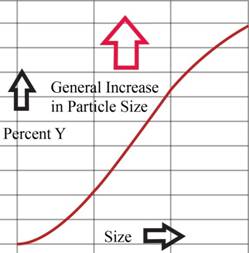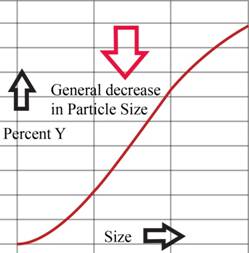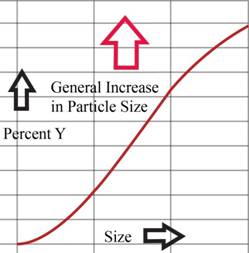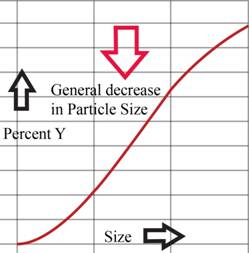
Concept explainers
(a)
The characteristic size of the product.
Answer to Problem 4.11P
The characteristic size of the product is
Explanation of Solution
Calculation:
Draw the table to calculate the corresponding
| Sieve Size (inches) |
Percent by weightFiner than Feed |
Linearised |
|
The slope calculated by the slope function in the excel sheet is,
The intercept calculated by the intercept function in the excel sheet is,
Write the expression to calculate the characteristic size.
Here, the characteristic size is
Substitute
Calculate the characteristic size for product.
| Sieve Size (inches) |
Percent by weightFiner than Product |
Linearised |
|
The slope calculated by the slope function in the excel sheet is,
The intercept calculated by intercept function in the excel sheet is,
Calculate the characteristic size for the product.
Substitute
Conclusion:
Thus, the characteristic size of the feed is
The characteristic size of the product is
(b)
If both the distributions fit the Rosin-Rammler particle size distribution function.
Answer to Problem 4.11P
Only the product distribution fits the Rosin-Rammler distribution function.
Explanation of Solution
Only the distribution for the product fits the Rosin-Rammler distribution function as in the feed distribution the characteristic size is of very high order of
Thus, only the product distribution fits the Rosin-Rammler distribution function.
(c)
The diagram for the particle size distribution curve for the given cases.
Answer to Problem 4.11P
- The feed becomes wetter (higher moisture content).
The particle size distribution curve is shown below.

The particle size distribution curve is shown below.

Explanation of Solution

Figure (1)
When the moisture content is increase the product size also increases considerably.

Figure (2)
When the shredder speed is increased the product size decreases considerably.
(d)
The effective power requirement.
Answer to Problem 4.11P
The effective power requirement is
Explanation of Solution
Calculation:
Write the expression to calculate the effective power requirement.
Here, the bond work index is
Substitute
Conclusion:
Thus, the effective power requirement is
Want to see more full solutions like this?
Chapter 4 Solutions
Solid Waste Engineering: A Global Perspective, Si Edition
- a. A b. A 3. Sketch normal depth, critical depth and the water surface profile. Assume at A and B the water is flowing at normal depth. Label and Identify all curves (i.e., M1, S2, etc.) Yn > Ye Уп Ye Уп> Ус yarrow_forward2. Design a trapezoidal ditch to carry Q = 1000 cfs. The ditch will be a lined channel, gravel bottom with sides shown below on a slope of S = 0.009. The side slopes of the 20-ft wide ditch will be 1 vertical to 3 horizontal. a) Determine the normal depth of flow (yn) using the Normal value for Manning's n. b) If freeboard requirements are 25% of the normal depth, how deep should the ditch be constructed? c) Classify the slope. T b Уп Z 1 Yn + FBarrow_forwardP15.45 WP A stainless steel pipe (Figure P15.45) with an outside diameter of 2.375 in. and a wall thickness of 0.109 in. is subjected to a bending moment M = 50 lb ft and an internal pressure of 180 psi. Determine the absolute maximum shear stress on the outer surface of the pipe. M FIGURE P15.45 Marrow_forward10.72 What power must the pump supply to the system to pump the oil from the lower reservoir to the upper reservoir at a rate of 0.3 m³/s? Sketch the HGL and the EGL for the system. p=940 kg/m³ v = 10-5 m²/s Elevation 100 m Elevation 112 m L= 150 m Oil Steel pipe D = 30 cm Problem 10.72arrow_forwardL / 83° 28° $75°E M 202° Q2: The scanning process was completed from point J to point N. The direction of the straight line was LM and the angles of deviation are shown in the figure below. Find the direction of the remaining sides? Narrow_forwardQ3: The scanning process was completed from point F to point G. The direction of the line Fl and the angles of deviation and interior are shown in the figure below. Find the direction of the remaining sides? Azimn = 60° F 52° 52° 72° R= 572.958/D ° T-R tan(A/2) • LC 2R sin (A/2) • E-R (sec(A/2)-1) • M-R (1-cos (A/2)) L= 10 A/D •C=2R sin(2D/2) • d=Dc/10 c' 2R sin (d/2) • Y= √√R2-X2-K • K= R2- K=R-M G H معادلات :مفيدةarrow_forwardPlease write me Background Reviews;arrow_forwardQ1/ The specific gravity of the soil is 1.41 percentage of water content by weight at field capacity and wilting point are 15% and 7% respectively calculate the equivalent moisture content as equivalent depth for 1.2m root zone : 1. at permanent wilting point 2. at field capacity 3. for ready available waterarrow_forwardKindy explain the pie chart percentage and give some related study and references about Value of travel time connected to the pie chartarrow_forwardConsider the specifications for an asphaltic concrete mixture and the results of a sieve analysis below. Coarse aggregates: Fine aggregates: Filler: 60% 35% 5% Percent of Weight of Aggregate or Filler Passing Sieve Designation Retained on Sieve Designation Coarse Aggregate Fine Aggregate Mineral Filler 3/4 in. (19 mm) 1/2 in. 6 1/2 in. (12.5 mm) 3/8 in. 15 3/8 in. (9.5 mm) No. 4 50 - No. 4 (4.75 mm) No. 10 20 1 No. 10 (2 mm) No. 40 (0.425 mm) No. 40 9 35 - No. 80 31 40 No. 80 (0.180 mm) No. 200 (0.075 mm) Total No. 200 - 33 - - 25 35 100 100 100 Determine the proportion of different aggregates to obtain the required gradation. Percent of Total Weight of Mixture Passing Sieve Designation Retained on Sieve Designation Coarse Aggregate Fine Aggregate 3/4 in. (19 mm) 1/2 in. (12.5 mm) 3/8 in. (9.5 mm) 1/2 in. 3/8 in. No. 4 No. 4 (4.75 mm) No. 10 No. 10 (2 mm) No. 40 No. 40 (0.425 mm) No. 80 No. 80 (0.180 mm) No. 200 No. 200 (0.075 mm) Total Need Help? Read It Mineral Filler Total 100arrow_forwardResults obtained from laboratory tests on a sample of RC-250 asphalt cement are given. Determine whether the properties of this material meet the Asphalt Institute specifications for this type of material; if not, note the differences. (For each specification, enter the minimum acceptab value in the same units as used in the test results.) • Kinematic viscosity at 140°F (60°C) = 230 centistokes • Flash point (Tagliabue open cup) = 89°F • Distillation test where distillate percent by volume of total distillate to 680°F (360ºC) • To 437°F (225°C) = 27% • To 500°F (260°C) = 69% • To 600°F (316°C) = 72% • Residue from distillation to 680°F (360°C) by volume percentage of sample by difference • Tests on Residue from Distillation: • Ductility at 77°F (25°C) = 92 cm • Absolute viscosity at 140°F (60°C) = 620 poises ⚫ Solubility = 90% Property Kinematic Viscosity = 74% Specification Test Results Were Specifications Met? centistokes 230 centistokes ---Select--- ✓ Flash Point °F 89°F…arrow_forwardProblem 2 Two machines produce rivets for a factory job. The number of sub-standard rivets per hour by the two machines are random variables, denoted by X1 and X2. The bivariate PMF of X1 and X2, Px,x,(x1,x2), is given in the table below. X2=0 X2=1 X2=2 X2=3 X₁-0 0.07 0.05 0.02 0.01 X₁ =1 0.05 0.16 0.12 0.02 X₁ =2 0.02 0.12 0.17 0.05 X₁ =3 0.01 0.01 0.05 0.07arrow_forwardarrow_back_iosSEE MORE QUESTIONSarrow_forward_ios
 Solid Waste EngineeringCivil EngineeringISBN:9781305635203Author:Worrell, William A.Publisher:Cengage Learning,
Solid Waste EngineeringCivil EngineeringISBN:9781305635203Author:Worrell, William A.Publisher:Cengage Learning, Fundamentals of Geotechnical Engineering (MindTap...Civil EngineeringISBN:9781305635180Author:Braja M. Das, Nagaratnam SivakuganPublisher:Cengage Learning
Fundamentals of Geotechnical Engineering (MindTap...Civil EngineeringISBN:9781305635180Author:Braja M. Das, Nagaratnam SivakuganPublisher:Cengage Learning Traffic and Highway EngineeringCivil EngineeringISBN:9781305156241Author:Garber, Nicholas J.Publisher:Cengage Learning
Traffic and Highway EngineeringCivil EngineeringISBN:9781305156241Author:Garber, Nicholas J.Publisher:Cengage Learning Materials Science And Engineering PropertiesCivil EngineeringISBN:9781111988609Author:Charles GilmorePublisher:Cengage Learning
Materials Science And Engineering PropertiesCivil EngineeringISBN:9781111988609Author:Charles GilmorePublisher:Cengage Learning Construction Materials, Methods and Techniques (M...Civil EngineeringISBN:9781305086272Author:William P. Spence, Eva KultermannPublisher:Cengage Learning
Construction Materials, Methods and Techniques (M...Civil EngineeringISBN:9781305086272Author:William P. Spence, Eva KultermannPublisher:Cengage Learning Fundamentals Of Construction EstimatingCivil EngineeringISBN:9781337399395Author:Pratt, David J.Publisher:Cengage,
Fundamentals Of Construction EstimatingCivil EngineeringISBN:9781337399395Author:Pratt, David J.Publisher:Cengage,





